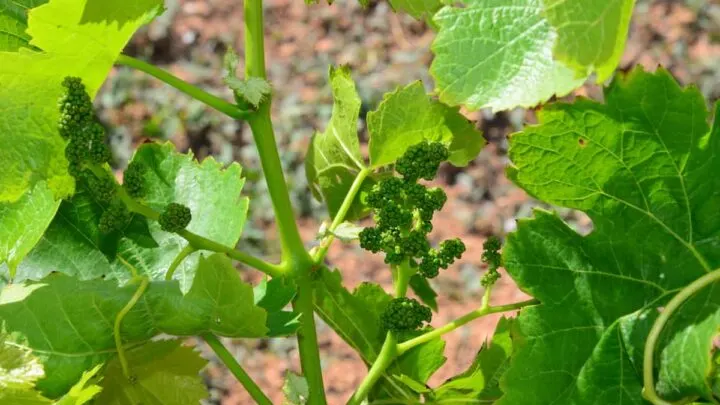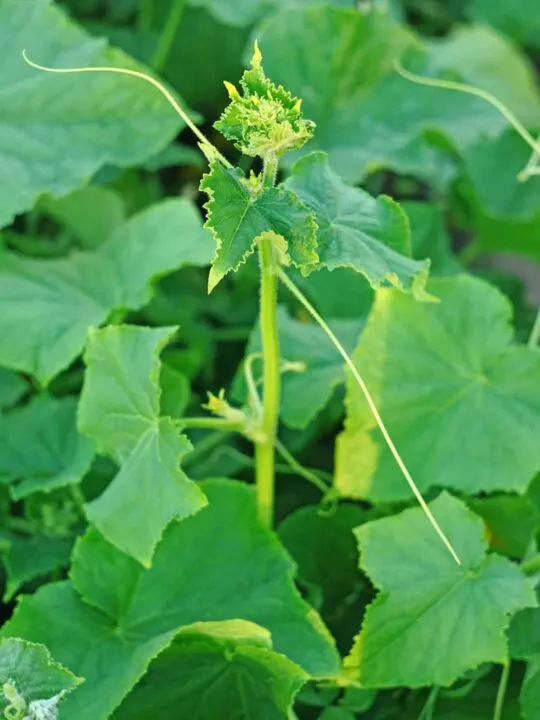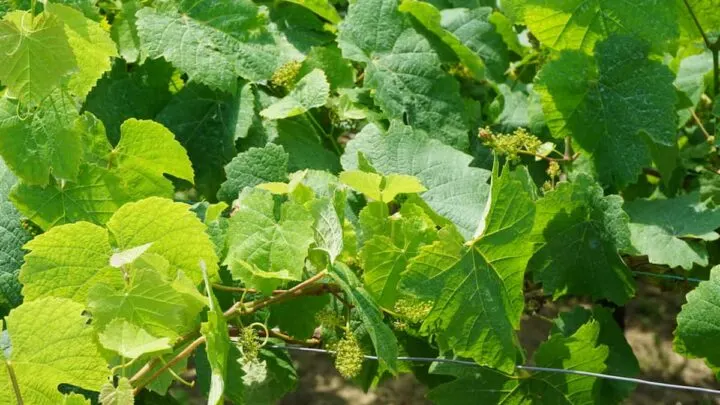Cucumbers are versatile, easy to grow, and can be added to many delicious dishes. While cucumbers are very easy to grow, they still have their issues. One of those issues is leaves curling down; something no gardener wants to see. But why would cucumber leaves curl down in the first place?
Curling cucumber leaves can be caused by inadequate watering. In addition, sudden changes in weather, pests like aphids, and even Furasium wilt can cause cucumber leaves to curl downward.
The article below discusses what happens when cucumber leaves start curling down, what causes this instance, and if any of the problems can be solved. Stick around!

What Causes Cucumber Leaves To Curl Down?
Several things cause cucumber leaves to curl down. Environmental changes, stressors, and things like pests and disease, can all cause a cucumber to curl. Let’s take a closer look.
Too Much or Too Little Water
One of the most common reasons that cucumber plant leaves appear to be curling down is the plant getting too much or too little water. When a plant gets too much water, the plant’s roots are waterlogged. The oxygen and nutrients that normally flows freely through the roots and into the plant’s system cannot flow when there is an excess of water.
This would cause the leaves to drop and curl as the rest of the plant isn’t getting the nutrients it needs. On the other hand, when a plant gets too little water, it doesn’t have the vital resource that keeps it alive. As a result, the plant curls its leaves to protect what little moisture is left in the leaves.
Weather Changes
Cucumbers tend to be a little picky about the weather. They are a warm weather plant that prefers the weather to be around 65-80 degrees. If the weather suddenly gets too cold or is very hot, over 80 degrees, for more than a few days, the plant is shocked. The plant will curl its leaves to protect itself.

Aphids
Another very common reason that causes leaf curl is aphids. They are a nasty little creature that comes into the garden and will pretty much eat everything.
Aphids feed and suck on the liquid from inside the leaves and stems of plants. This causes the plant to lose moisture and nutrients, thus causing leaf curl. Aphids can also transmit diseases from plant to plant. These diseases can also cause leaf curl (see below).
Mosaic Virus
Mosaic virus is transmitted by aphids and can quickly take over gardens. Symptoms of mosaic virus are leaf spots, leaf yellowing, leaf decay, stunted growth, spots on fruit, disfigured fruit, and leaf curl.
Fusarium Wilt
Fusarium wilt is a very nasty disease that is transmitted through the soil and can be tricky to get rid of. Fusarium wilt starts near the base of the plant, first curling the bottom leaves, yellowing them, and causing them to decay. As the disease spreads, the plant fairly quickly starts dying.
How To Fix Leaf Curl in Cucumbers
Luckily, most of the things causing the leaf curl damage can be fixed. Most of the time, it is very easy to find the cause of the leaf curl and change some things to reverse the curl. The sooner you find the problem and fix it; the less your yield will suffer.

Water Schedule
Cucumbers are heavy water feeders. It makes sense because so much of them are made up of water. It is essential when growing cucumbers to have them on a strict and regular watering schedule. This is to ensure that your plant never gets over-watered or under-watered.
If you suspect your plant is getting too much water, you must let your cucumber plants dry out for a few days before watering them again. If you suspect your plants need more water, then water immediately. Cucumbers need around 2 inches of water a week. The best way to reach this goal is by watering every 2-3 days. If it is extremely hot out, it is best to water every day.
Weather
When it comes to weather, there isn’t much we can do but be prepared. When we first start planting cucumbers, it is best to plant them outdoors two weeks after the last frost date. It is important to get them early enough that they don’t get the summer heat, but not too early because they will not germinate in the cold temperatures.

If you have cold weather coming through, the best thing to do is to protect your plants. You can do this by putting plastic around your plants (similar to the greenhouse idea) or covering your plants with leaves, cardboard, or anything to help keep heat in.
Placing mulch around your plants will also help keep the soil warm. When hot weather is coming through, the only thing you can do is either put up a shade cloth during the hottest parts of the day and water frequently.
Aphids
Luckily, aphids aren’t too terrible if you catch them quickly. Not only will you notice leaf curl, but you will also be able to see clusters of the tiny bugs on the undersides of leaves. They can easily be gotten rid of using a few techniques.

Spraying with Water
A very simple and easy way to knock aphids off your cucumber plants is to simply wash your plants off. You can use somewhat of a forceful stream, careful not to damage any branches.
You should also do this in the morning on a warmer day so the plants have time to dry off. Remember that spraying the bugs away will not kill them; they will likely come back if you do nothing else.
Neem Oil
Neem oil is a favorite used by many gardeners. It comes in a liquid form that you can mix with water. Spray it on your leaves every 7-10 days until you start seeing results.
Insecticidal Soap
There are many different kinds of insecticidal soaps. Most have a potassium base and are all-natural. Usually, you can buy a spray bottle of insecticidal soap and spray your plants down every 7-10 days.
Diatomaceous Earth
Diatomaceous earth can be used in conjunction with anything above. It is great at getting rid of bugs and keeping them away. Sprinkle diatomaceous earth around your garden, or anywhere you don’t want aphids.
Mosaic Virus and Fusarium Wilt
Unfortunately, for both of these diseases, there is no cure. Hopefully, you are far along enough where you can harvest your cucumbers and get rid of the plants.
The only way to stop the diseases from spreading is to pull them out of the ground and burn them or throw them away. NEVER compost diseased plants; this will only spread the diseases further.
Final Thoughts
Cucumber leaf curl can be a bit startling. It can be hard to see your plants in distress. However, it may be something as simple as a water or weather issue. As long as you find out the problems and fix whatever is going on, your cucumbers can remain growing happily and healthy! Happy gardening!

Hi there, my name is Allie and welcome to my blog; GareningWithAllie!
Much of what you see written here is just our personal experiences with gardening. Along with the content I write here, there is also a unique collection of gardening topics covered by some of our close friends. I hope you find everything you read here to be helpful, informative, and something that can make your gardening journey the most lovely experience ever! With that said, Happy Gardening!
